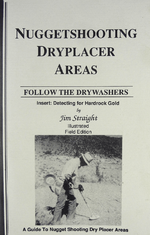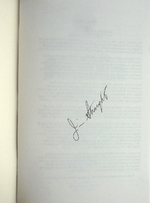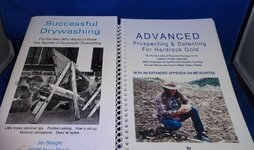Does gold in a desert wash sink all the way down to bedrock. My thought is due to water only traveling through it maybe a few times a year, wouldn't most of the gold be in the first few inches? Would it be a waste of time digging down 3-4 feet to bedrock in a drywash.
Navigation
Install the app
How to install the app on iOS
Follow along with the video below to see how to install our site as a web app on your home screen.
Note: This feature may not be available in some browsers.
More options
You are using an out of date browser. It may not display this or other websites correctly.
You should upgrade or use an alternative browser.
You should upgrade or use an alternative browser.
Gold in desert washes
- Thread starter mu50stang
- Start date
Tree!
Jr. Member
From my experience, it's best to test every layer down to bedrock.
It seems like it changes between every flood, depending on how powerfully the water was flowing.
Just run about four buckets for each foot you go down until you're at bedrock and whichever layer had the most gold is going to be the place to start. Shovel off that overburden until you get into that layer. Periodically test again since the bedrock sometimes changes depth just so you're sure you're not throwing any good gold out!
Hope you use a vac and a metal detector in conjunction with your mining!
It seems like it changes between every flood, depending on how powerfully the water was flowing.
Just run about four buckets for each foot you go down until you're at bedrock and whichever layer had the most gold is going to be the place to start. Shovel off that overburden until you get into that layer. Periodically test again since the bedrock sometimes changes depth just so you're sure you're not throwing any good gold out!
Hope you use a vac and a metal detector in conjunction with your mining!
Justbent
Full Member
I think they call that "flood gold".
If the wash has gold in it, most should be on bedrock....I would think.
If the wash has gold in it, most should be on bedrock....I would think.
Hard Prospector
Hero Member
- Aug 29, 2012
- 974
- 1,387
- Detector(s) used
- SDC2300, Gold Monster, Sierra Gold Trac, GB2, the Falcon......and just as many drywashers
- Primary Interest:
- Prospecting
Do you guys consider desert washes good for drywashing or prefer to work alluvial fans, residual placer bleed off, ancient tertiary material etc. Although I have a lot of experience nugget shooting in the desert, I'm adding in drywashing. I feel the best way to fast track any learning curve is to respectfully ask questions to those who already know the program well.....Thanks
roadrunner
Bronze Member
- Jan 28, 2012
- 1,230
- 524
- Detector(s) used
- Garrett Groundhog-2012-1st MD.
White's Goldmaster V/Sat-2nd-MD-2013
Tesoro Lobo-2015-3rd
- Primary Interest:
- Prospecting
Most of our gold in our washes in Az are in the top 6 inches. We dont get that much water to move it down deeper.
Or it is behind rocks, boulders, tress, roots ect in the top 3 inches.
If it goes down it will hit cemented gravels or caliche and wont even make it down the 16 feet or more to bedrock.
Could be down as far as 1600 feet,the true bedrock.
Or it is behind rocks, boulders, tress, roots ect in the top 3 inches.
If it goes down it will hit cemented gravels or caliche and wont even make it down the 16 feet or more to bedrock.
Could be down as far as 1600 feet,the true bedrock.
rodoconnor
Bronze Member
- Mar 4, 2012
- 1,419
- 1,639
- Primary Interest:
- All Treasure Hunting
Mustang,H/P read Jim Straight's books. A real" fast track". Read them 2 or 3 times.
Hard Prospector
Hero Member
- Aug 29, 2012
- 974
- 1,387
- Detector(s) used
- SDC2300, Gold Monster, Sierra Gold Trac, GB2, the Falcon......and just as many drywashers
- Primary Interest:
- Prospecting
I have several of Jim's books, great stuff.
roadrunner
Bronze Member
- Jan 28, 2012
- 1,230
- 524
- Detector(s) used
- Garrett Groundhog-2012-1st MD.
White's Goldmaster V/Sat-2nd-MD-2013
Tesoro Lobo-2015-3rd
- Primary Interest:
- Prospecting
I have 2 books so far from Jim Straight.
Follow the Drywashers.
Advanced Prospecting & Detecting for Hardrock Gold.
I would recomend his books to any one.
Follow the Drywashers.
Advanced Prospecting & Detecting for Hardrock Gold.
I would recomend his books to any one.
Last edited:
AzViper
Bronze Member
- Sep 30, 2012
- 2,038
- 2,251
- Detector(s) used
- Fisher Gold Bug Pro, Nokta FORS Gold, Garrett ATX, Sun Ray Gold Pro Headphones, Royal Pick, Etc.
- Primary Interest:
- Prospecting
roadrunner
Bronze Member
- Jan 28, 2012
- 1,230
- 524
- Detector(s) used
- Garrett Groundhog-2012-1st MD.
White's Goldmaster V/Sat-2nd-MD-2013
Tesoro Lobo-2015-3rd
- Primary Interest:
- Prospecting
ay to go. I picked mine up there also.
$18, free shipping. Volume 3, 6th edition.
Mines signed also. Wonder if he signed all his books.
Mine does not have the insert.
$18, free shipping. Volume 3, 6th edition.
Mines signed also. Wonder if he signed all his books.
Mine does not have the insert.
AzViper
Bronze Member
- Sep 30, 2012
- 2,038
- 2,251
- Detector(s) used
- Fisher Gold Bug Pro, Nokta FORS Gold, Garrett ATX, Sun Ray Gold Pro Headphones, Royal Pick, Etc.
- Primary Interest:
- Prospecting
roadrunner
Bronze Member
- Jan 28, 2012
- 1,230
- 524
- Detector(s) used
- Garrett Groundhog-2012-1st MD.
White's Goldmaster V/Sat-2nd-MD-2013
Tesoro Lobo-2015-3rd
- Primary Interest:
- Prospecting
Have the one on the right also.
Not the left, have to go to ebay and see if I can get one for cheap.
Well, I know I can because I will bid snipe it if I have to.
Not the left, have to go to ebay and see if I can get one for cheap.
Well, I know I can because I will bid snipe it if I have to.
hvacker
Bronze Member
Have the one on the right also.
Not the left, have to go to ebay and see if I can get one for cheap.
Well, I know I can because I will bid snipe it if I have to.
A well learned lesson. If it has value, pay for it. Sometimes you only cheat yourself.
hvacker
Bronze Member
Have the one on the right also.
Not the left, have to go to ebay and see if I can get one for cheap.
Well, I know I can because I will bid snipe it if I have to.
A well learned lesson. If it has value, pay for it. Sometimes you only cheat yourself.
augoldminer
Sr. Member
- Jan 7, 2013
- 329
- 326
- Detector(s) used
- gold master V-sat
- Primary Interest:
- All Treasure Hunting
What most gold hunters do not understand is what is desert now may not have been desert 5000 years ago and 13,000 years ago may have been forest. or under water.
the Pleistocene Lake Lahontan, in Nevada covered a large area.
GECSC: Paleoclimate Variability of the American Southwest
Most of the gold in the southwest predates the last ice age. 3,000,000 years.
What is dry valleys now may have been lakes with beach deposits.
the Pleistocene Lake Lahontan, in Nevada covered a large area.
GECSC: Paleoclimate Variability of the American Southwest
Most of the gold in the southwest predates the last ice age. 3,000,000 years.
What is dry valleys now may have been lakes with beach deposits.
roadrunner
Bronze Member
- Jan 28, 2012
- 1,230
- 524
- Detector(s) used
- Garrett Groundhog-2012-1st MD.
White's Goldmaster V/Sat-2nd-MD-2013
Tesoro Lobo-2015-3rd
- Primary Interest:
- Prospecting
How would we find out what areas used to be old rivers or drainage.
kazcoro
Hero Member
- Feb 11, 2013
- 876
- 357
- Detector(s) used
- Gold Bug Pro, Gold Buddy drywasher, Black Magic, Pro Gold recirc, Custom highbanker/2.5" dredge, Roadrunner Member
- Primary Interest:
- Prospecting
I would think the place to be would be where the ancient runoff rivers ran into the ancient lakes? I am just like you Roadrunner, I was looking for the AZ map.
roadrunner
Bronze Member
- Jan 28, 2012
- 1,230
- 524
- Detector(s) used
- Garrett Groundhog-2012-1st MD.
White's Goldmaster V/Sat-2nd-MD-2013
Tesoro Lobo-2015-3rd
- Primary Interest:
- Prospecting
Thats what i was looking for.
As an example, when hwy 60 goes across the road at Florence junction, you have 79 that runs south. But,all the hills and mountains from Gonzales pass, the runoff heads towards hwy 79.
That area is now the Nat Quard firing range,state land,blm,ect.
Now I would think that that area would make a perfect lake bead, or low area for all the water from that mountain range to collect.
There are some and where a few claims in that area also.
I am thinking about hitting that area, but I need to look at a topo or something as where to start.
I am going to get the book fistfulls of gold to start with this week.
As an example, when hwy 60 goes across the road at Florence junction, you have 79 that runs south. But,all the hills and mountains from Gonzales pass, the runoff heads towards hwy 79.
That area is now the Nat Quard firing range,state land,blm,ect.
Now I would think that that area would make a perfect lake bead, or low area for all the water from that mountain range to collect.
There are some and where a few claims in that area also.
I am thinking about hitting that area, but I need to look at a topo or something as where to start.
I am going to get the book fistfulls of gold to start with this week.
The geology of the Western US was created primarily in the Laramide Orogony from 80 million to 35 million years ago. Although not exclusively the origin of today's gold deposits it is the origin of most. The desert Southwest presents very few opportunities to explore intact gold bearing water deposit features.
The basin and range of Southern California, Nevada and Arizona has many placer gold deposits but I've only found one in my 40+ years of prospecting that was related to an ancient river system. This deposit consists of late tertiary cemented river gravels stranded in two small remaining deposits high on the south side of the Black Range in central Arizona. Good gold was found there. I have discovered another on the upper Pecos drainage in New Mexico but there is no evidence of gold in that conglomerate.
I'm sure there are more somewhere in the Basin and Range Province but my point is alluvial deposits, such as the tertiary gravels of the California Sierra Nevada, are not a significant source of placer gold in the desert Southwest in my experience.
We have mapped the Tertiary gold bearing gravels of the Sierra. When studying these deposits it quickly becomes evident that the ancient locations of these rivers have very little relationship to where their gravels are found today. Trying to puzzle out the where the gravels from an ancient water feature would be found today is truly an exercise in futility. Earth stuff moves in mysterious ways over millions of years.
When looking for gold bearing water influenced features in the desert Southwest you will have much more success studying the detrital semi alluvial fans so present in the southwestern deserts. Often the detrital clasts are mistaken for river gravels. These are the source of much of the placer gold concentrations to be found in this arid environment. A wise prospector would study in place deposition and deflation concentrations as well. These latter deposits tend to be small but very rich. Perfect for the small scale prospector/miner.
To answer the original question - it depends. Seldom are the best concentrations found on bedrock. In most of the detrital pediment deposits in the desert it would be very unlikely to find gold on bedrock even if you could dig that far down. Where gold is found on bedrock metal detectors and vacuums become the tools of choice. Sorry there is not a more definitive answer but, in the end, the fact is gold is where you find it.
The basin and range of Southern California, Nevada and Arizona has many placer gold deposits but I've only found one in my 40+ years of prospecting that was related to an ancient river system. This deposit consists of late tertiary cemented river gravels stranded in two small remaining deposits high on the south side of the Black Range in central Arizona. Good gold was found there. I have discovered another on the upper Pecos drainage in New Mexico but there is no evidence of gold in that conglomerate.
I'm sure there are more somewhere in the Basin and Range Province but my point is alluvial deposits, such as the tertiary gravels of the California Sierra Nevada, are not a significant source of placer gold in the desert Southwest in my experience.
We have mapped the Tertiary gold bearing gravels of the Sierra. When studying these deposits it quickly becomes evident that the ancient locations of these rivers have very little relationship to where their gravels are found today. Trying to puzzle out the where the gravels from an ancient water feature would be found today is truly an exercise in futility. Earth stuff moves in mysterious ways over millions of years.
When looking for gold bearing water influenced features in the desert Southwest you will have much more success studying the detrital semi alluvial fans so present in the southwestern deserts. Often the detrital clasts are mistaken for river gravels. These are the source of much of the placer gold concentrations to be found in this arid environment. A wise prospector would study in place deposition and deflation concentrations as well. These latter deposits tend to be small but very rich. Perfect for the small scale prospector/miner.
To answer the original question - it depends. Seldom are the best concentrations found on bedrock. In most of the detrital pediment deposits in the desert it would be very unlikely to find gold on bedrock even if you could dig that far down. Where gold is found on bedrock metal detectors and vacuums become the tools of choice. Sorry there is not a more definitive answer but, in the end, the fact is gold is where you find it.
elgatodelnoche
Sr. Member
- Aug 21, 2013
- 333
- 119
- Detector(s) used
- Garrett Deepseeker ADS
- Primary Interest:
- Prospecting
I shovel down to bedrock and don't fool with flood gold. It has been non existent in areas I work with dry washers in the Picketpost Mountain, Goldfield Mountains, and Superstition Mountain areas. When a gusher comes along, everything gets classified right quickly. Once on bedrock I will hammer and chisel it mercilessly to get into all the cracks. I really need to make another blower vac as they are the handiest piece of kit I have ever seen.
Top Member Reactions
-
 3457
3457 -
 2041
2041 -
 1962
1962 -
 1161
1161 -
 1108
1108 -
 924
924 -
 825
825 -
 807
807 -
 806
806 -
 788
788 -
 746
746 -
 529
529 -
 478
478 -
 475
475 -
 445
445 -
 422
422 -
 416
416 -
 416
416 -
E
415
-
 392
392
Users who are viewing this thread
Total: 2 (members: 0, guests: 2)







